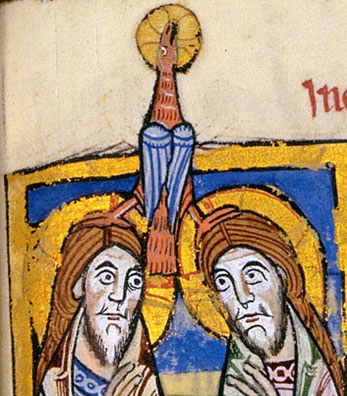Image © Hildesheim, St Godehard
Image
© Hildesheim, St Godehard |
| Context: |
Litany
|
| Iconography: |
A
kneeling tonsured monk stands between two groups of women who hold
up books. The books are inscribed with the beginning of the litany.
The left book reads God the father of heaven have mercy. God the
son redeemer of the world have mercy. The right book reads God
the Holy Spirit have mercy. Holy Trinity one God have mercy.
By holding the books aloft, it is the women who are appealing to the
Holy Trinity. The dancing tonsured monk is attracting attention to
their prayers. The leading woman, on the left, reaches from the temporal
zone into the heavenly zone. On the left stand two similar nimbed
figures, blessing, with the dove of the Holy Spirit on their heads.
They are the Holy Trinity.The humans in this image do not derive from
the text but are a deliberate choice, whereby a group of women, assisted
by a monk, appeal to the Holy Trinity. This suggests that the litany
is for these women and they are the ones who say it
|
| Art: |
The
dove was originally drawn with outspread wings, but they have been
painted closed, in repose.This is the first page where the lines for
the central column, scored since p331,
are used
|
| Thread
stitch: |
yes,
red threads attached
|
| Historical
Relevance: |
In
Christina's vision (Talbot, 1998, 156-7) she 'saw herself in a kind
of chamber, pleasing in its material, design and atmosphere, with
two venerable and very handsome personages clothed in white garments.
Standing side by side, they differed neither in stature nor beauty.
On their shoulders a dove far more beautiful than any others seemed
to rest. Outside she saw the abbot trying without success to gain
entrance to her... she pleaded with the Lord to have mercy on her
beloved'. The deliberate alteration of the dove from outstretched
to closed wings may be an attempt to reflect the vision of the dove
at 'rest' more accurately (Peter Kidd, pers. comm).Talbot (p26) considered
that this invocation of the Holy Trinity must have been painted after
the formal dedication of Markyate to the Holy Trinity in 1145. However,
the illustration clearly reflects Christina's vision which is recorded
in her Life after her profession c.1131 and before the acccession
of King Stephen (1135).
|
| Quire: |
22
|
|

![]()